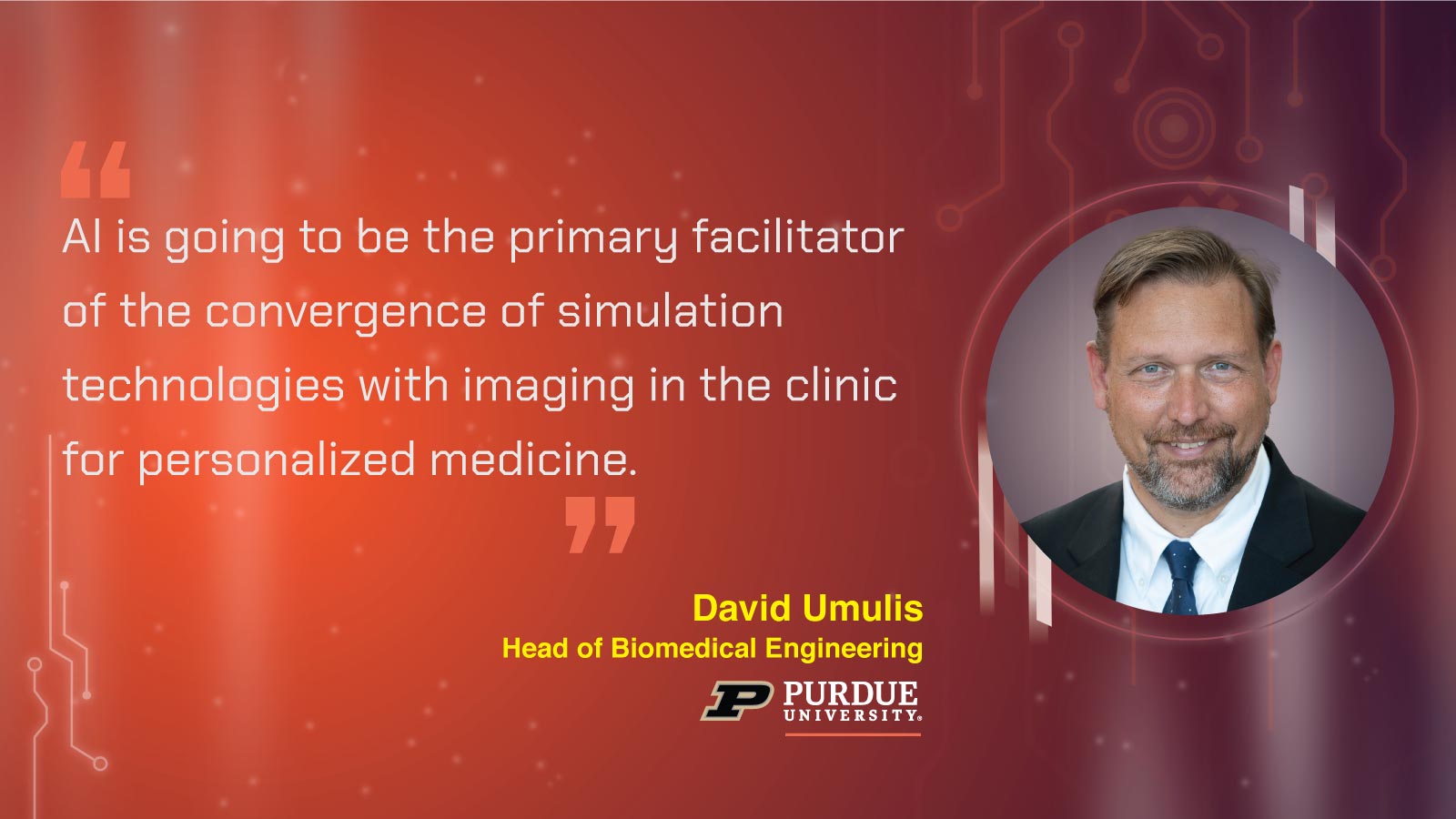AiThority Interview with David Umulis, Head of Biomedical Engineering at Purdue University

Hi David, welcome to AIThority Interview Series. Please tell us about your journey in the biomedical engineering industry?
Hi Sudipto. I’ve always had an interest in computers. As a child of the 80s and 90s, I witnessed an incredible transformation of technology and spent a lot of time trying to optimize config.sys, autoexec.bat, IRQ and COMM settings to access games and CAD software to run on high school computers. This triggered a nascent interest in coding, modeling, and optimization, which evolved into my research interests at the interface of developmental biology, engineering, and medicine. I pursued a degree in chemical engineering, which served as a natural gateway into more sophisticated computational modeling by simulating embryo development and integrating image data to determine how encoded genetic information is processed to give rise to patterns and the structure and function of a living organism. Many diseases are related to dysfunction of these complex developmental pathways, and with this large complexity the best way to discover how these systems worked was through the convergence of compute/imaging/genetics… and now AI.
Please tell us about EMBRIO project and what kind of backing has it acquired from the NSF and Purdue University?
The EMBRIO Institute project focuses on signal integration at the cellular and tissue levels. When cells or tissues are damaged or attacked by a pathogen or environmental factor, many signals are generated that need to be processed by the cells to respond to what is happening. If you poke the skin on your hand, you feel it,-and cells sense it. They also sense chemicals, heat, and other environmental factors. They combine the information from multiple sensors and respond to it by mounting a defensive response or increasing the structural integrity of the cell. Cells also tell their neighbors to mount a collective response through the signaling networks. This behavior underpins cellular defense and wound repair. The Institute focuses on how the signals are generated and integrated to mount the response. To address this, we need the most advanced technologies, both in biology and genetics, as well as on the data and simulation sides. AI plays a big role in this project. It provides the pragmatic tools to process our massive imaging data sets as it converts the data into information through the identification of cellular structures and physiological signals. AI is also used to speed up our simulations many times over. It allows a greater scale of convergence between the experimental and computational tools and supports the integration of engineering tools into biological discovery. The NSF Bio Integration Institutes (BII) program provides the primary support for the EMBRIO Institute that spans six universities. Purdue has also strongly supported the effort through acquisition of new imaging technologies, new facilities for the institute researchers, and supercomputing support through the Rosen Center for Advanced Computing.
Recommended: AiThority Interview with Amy White, Director of Social Impact and Communications at Adobe
How is Artificial Intelligence transforming biomedical engineering?
AI is currently transforming biomedical engineering in many pragmatic ways for practitioners. It’s very well suited to improve biomedical imaging and pathology workflows. AI is well known for its capabilities in processing images and this manifests in biomedical engineering through improvements in image quality from MRI and CT imaging systems. There is a growing interest of application of machine learning in identifying and categorizing tumors and other pathologies. However, in my view, AI is going to be the primary facilitator of the convergence of simulation technologies with imaging in the clinic for personalized medicine. For example, there’s a lot of value in computing blood flow patterns in aneurisms or in patient-specific heart models. However, the length of time it takes to perform the needed computations is not practical. One area that has seen a lot of growth is in the use of AI to accelerate these complex simulations to the point where digital representations of individual physiology with predicted outcomes can become common practice. AI is also useful for sensor convergence. We are more connected than ever, and now wearable devices and sensors have the capability to monitor health for wellness, for patient care, and for advanced clinical trials. These produce massive amounts of continuous data that AI can monitor for subtle changes in an individual and thereby identify predictive capability through the fusion of multiple simultaneous sensors monitoring heart function, electrical signals, blood chemistry including glucose, personal activity, etc.
Please tell us about some of your AI ML research works in the life sciences / biomedical engineering that could change the way the world in the near future.
AI has really been a transformative technology in biology, medicine, and biomedical engineering. And you know what? We are just scratching the surface of capabilities! One way that AI could change the future is in telemedicine, in interpreting multimodal sensor information, and providing more information-rich data to practitioners. A near term application of AI that the EMBRIO Institute project provides is a test case for the ability to translate findings from one organism or species to another. This is a complex process and many, many drugs fail in clinical trials because the findings from preclinical models do not effectively translate to their correlated action in human trials. The biological pathways that are targeted by drugs are very complex and embedded in a context of other pathways. Recent findings made through the application of AI between different species shows how predictions can be improved by incorporating context in the predictions and training. Eventually this could lead to a future application that connects sequence and DNA-pattern extraction to cell signaling networks for more individualized care and selection of more suitable drugs.
Recommended: AiThority Interview with Julie Lock, Senior Manager, UK&I Marketing at HubSpot
What tips would you like to offer to succeed in addressing ethical problems associated with developing Explainable AI (X-AI) or Responsible AI?
As part of our EMBRIO team, we have a faculty lead who specializes in this question. Currently, we are in the early stages of generating all the training data from images across the different biological species in the Institute. Machine learning models are fully transparent and we possess tools to investigate their bias and the role of datasets in biasing answers and results. As such we are confident we can provide a pipeline that is fair and responsible.
How do you handle the challenges related to Ethics and Bias in AI at Purdue/ EMBRIO?
The application spaces where AI is being applied in the EMBRIO Institute are biological model organisms commonly used in the field of biology. Often challenges of Ethics and Bias in AI have to do with the training sets used and a lack of underrepresented minorities in the training sets, or socio-economical factors, which introduce bias. This is not within the scope of our current project in the EMBRIO Institute.
Your predictions on the future of AI talent and expanding demands from the startups and research companies:
The future of AI research in biomedical engineering and medicine is VERY BRIGHT. This will be supported by greater digitization of healthcare, a growing focus on wellness, and greater convergence between engineering and medicine. In the EMBRIO Institute we hosted our first annual workshop, which included over 50 participants who attended in order to learn simulation technologies and be introduced to how the Institute is using AI.
Your advice to young AI engineers looking to adopt to ever-expanding data science technology innovations for biomedical field:
As a student, it’s always a good idea to position yourself in a space where demand far outstrips supply. Experience in AI as a young engineer gives you an opportunity to leapfrog your career and become a leader in an innovative and fast-paced area. This has been a big part of the strategic goals of the EMBRIO Institute – to train and support the next generation STEM workforce in AI and multidisciplinary approaches at the interface of biology and engineering.
Recommended: AiThority Interview with Ian Randolph, Head of Product and R&D at Tailify
A technology event/ conference/ webinar/ podcast that you would like to attend in 2022-2023:
AIME- Artificial Intelligence in Medicine 2023
Thank you, Eran! That was fun and we hope to see you back on AiThority.com soon.
[To share your insights with us, please write to sghosh@martechseries.com]
Dr. David M. Umulis is the Dane A. Miller Head and Professor of the Weldon School of Biomedical Engineering at Purdue University and Director of the NSF-funded EMBRIO Institute. Umulis leads the Weldon School to advance discovery and translation research in biomedical imaging, neuroengineering, instrumentation and devices, computational biomedicine, and engineered biomaterials. He is regarded as an impactful research leader, widely respected mentor to young faculty colleagues and an administrator with a proven track record. In 2021, Umulis led a collaborative team of more than 20 faculty from six universities in the development of a new NSF-funded institute that uses simulation and AI combined with cell biology to discover mechanisms of wound repair and cellular defense. This is an extension of his innovative work that uses high performance computing and AI to support biological discovery in organismal development.
Purdue University is Indiana’s land-grant institution with a mission to spur the statewide and regional economy by preparing a well-educated workforce and contributing discovers that lead the innovation and commercialization. The Weldon School of Biomedical Engineering is persistent in the pursuit of nurturing highly motivated students and faculty in biomedical devices, healthcare delivery and related life sciences, and supporting discovery-based translational research to develop innovative technologies for clinical and public health uses. The School has five research areas of excellence: Engineered Biomaterials and Biomechanics; Imaging; Instrumentation; Computational Biomedicine; and Neuroengineering and Neuortechnology.









Comments are closed.